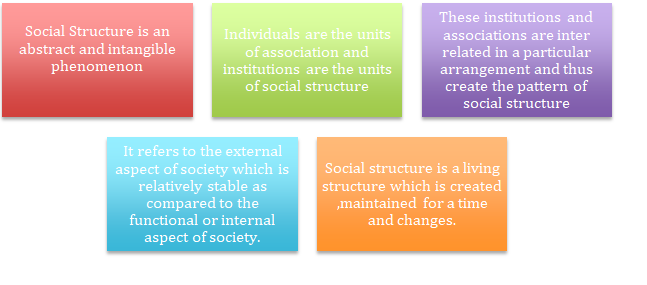Home » Social Structure
Social Structure
The term structure refers to some sort of ordered arrangement of parts or components. A musical composition has a structure; a sentence has a structure etc. In all these we find an ordered arrangement of different parts. A structure can be called a building only when these parts or components are arranged in relationship with the other. In the same manner society has its own structure called social structure. The components or units of social structure are persons. A person is a human being that occupies position in a social structure. Even though the persons are subject to change the structure as such maintains its continuity. A nation, tribe, a political party, a religious body can continue in existence as an arrangement of persons though the personnel of each changes from time to time. There is continuity of structure just as a human body maintains its structure. Sociologists speak of few kinds of structures or groups that will be present in all societies. These structures will exist in any society regardless of its ethos, history or any cultural variability. Because without the functions of these structures a human society cannot survive. Thus a family may be monogamous or polygamous; a government may be democratic or authoritarian; an economy may be socialist or capitalist. The nature of the specific structure may vary from society to society but there always be a structure resulting in a function.
Social Structure Definition
The concept of social structure has been defined in different ways by different thinkers and sociologists. Herbert Spencer was the first thinker who wrote about structure of a society. He came up with biological analogies (organic structure and evolution) to define the social structure.
According to Radcliff-Brown social structure is a part of the social structure of all social relations of person to person. In the study of social structure the concrete reality with which we are concerned is the set of actually existing relations at a given moment of time that link together certain human beings.
A more general definition of social structure is that social structure refers to the enduring orderly and patterned relationships between the elements of a society. According to Raymond Firth it makes no distinction between the ephemeral and the most enduring elements in social activity and it makes it almost impossible to distinguish the idea of the structure of society from that of the totality of the society itself.
According to S.F Nadal structure refers to a definable articulation and ordered arrangement of parts. It is related to the outer aspect or the framework of society and is totally unconcerned with the functional aspect of society. So he has emphasized that the social structure refers to the network of social relationship that is created among the human beings when they interact with each other according to their statuses in accordance with the patterns of society. He has emphasized that the social structure refers to the network of social relationship that is created among the human beings when they interact with each other according to their statuses in accordance with the patterns of society.
According to Ginsberg the study of social structure is concerned with the principal form of social organization that is types of groups, associations and institutions and the complex of these that constitute societies.
According to Karl Mannheim social structure refers to the web of interacting social forces from which have arisen the various modes of observing and thinking. Social structure is an abstract and intangible phenomenon Individuals is the units of association and institutions are the units of social structure. These institutions and associations are inter-related in a particular arrangement and thus create the pattern of social structure. It refers to the external aspect of society that is relatively stable as compared to the functional or internal aspect of society. Social structure is a living structure that is created, maintained for a time and changes.
According to Talcott Parsons, the term social structure applies to the particular arrangement of the interrelated institutions, agencies and social patterns as well as the statuses and roles which each person assumes in the group. Parsons has tried to explain the concept of social structure in abstract form. All the units of social structure that is institutions, agencies, social patterns, statuses and roles are invisible and intangible and hence are abstract. According to Maclver and Page the various modes of grouping together comprise the complex pattern of the social structure. They have also regarded that social structure is abstract which is composed of several groups like family, church, class, caste, state or community etc.
According to Johnson, the structure of anything consists of the relatively stable inter-relationships among its parts; the term part itself implies a certain degree of stability. Since a social system is composed of the inter-related acts of people, its structure must be sought in some degree of regularity or recurrence in these acts.
What is Social Structure in Sociology?
On the basis of the definitions social structure can be understood in the following points

|
|
Notes on Concepts of Social Structure
- Perspectives on Social Structure
- Elements of Social Structure
- Structuralism
- Formal and Informal Structure
- Types of Social Structure
- Social Structure and Social Organization
- Social Structure and Role
- Important Terms

 |
© 2024 Sociology Guide.Com |
 |













